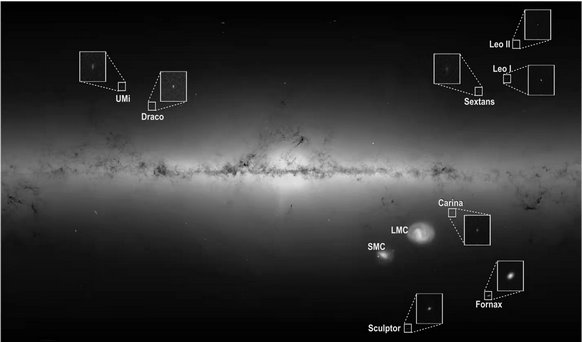Coming at a surprise: Milky Way companion galaxies are mostly newcomers
Dwarf galaxies in the vicinity of the Milky Way are believed to be its satellites, much like the Earth orbiting the Sun. The new Gaia data released at the end of 2020 indicates that they have much higher energies and angular moments than known Milky Way satellites. Rather, most dwarf galaxies are new comers in the Galaxy surroundings, which is the conclusion of the international team of the Observatoire de Paris - PSL au department Galaxies, étoiles, physique et instrumentation - GEPI, of the National Astronomical Observatory of the Chinese Academy of Sciences (NAOC), and of the Leibniz Institute for Astrophysics at Potsdam (AIP). Published online on November 24, 2021 in The Astrophysical Journal, the study calls into question many ideas about our Galaxy and its environment.
For decades, dwarf galaxies surrounding the Milky Way have been believed to be satellites. They are viewed as our constant companions for many billion years. This is reflected in many research articles or online courses in astrophysics. Now the Gaia results are so precise that the above hypothesis can be tested, and the result came at a full surprise.
An international scientific team of the Observatoire de Paris - PSL au department Galaxies, étoiles, physique et instrumentation - GEPI, of the National Astronomical Observatory of the Chinese Academy of Sciences (NAOC), and of the Leibniz Institute for Astrophysics at Potsdam (AIP), has exploited the most accurate astrometric data available to date. The motions of dwarf galaxies in the sky have been revealed with unprecedented precision after the publication of the third catalogue Gaia in December 2020.
The team has taken these results and calculated the three-dimensional velocities for each of the 40 dwarf galaxies detected by Gaia. Then, from these velocities and the dwarf galaxy locations, the team calculated their orbits, and has derived the fundamental quantities of their orbital energies, and their angular (rotational) momenta.
Surprisingly, these last quantities are much larger compared to those of the other populations of the Galaxy surroundings, either giant stars, or clusters of stars called globular clusters. The inhabitants of the Galaxy outskirts have angular energies and momenta that decrease with time, due to the different energy losses that they undergo when they are in orbit. The longer they are in orbit, the weaker their energies and angular momenta.
Many giant stars surrounding the Galaxy result from a former collision that has formed the Milky Way eight to ten billion years ago. Other stars lie in a gigantic stellar stream, which corresponds to the fall and destruction of the Sagittarius dwarf galaxy in the Milky Way, 4 to 5 billion years ago. The study concludes that many of the dwarf galaxies inhabiting the Galaxy outskirts have reached them much more recently, only a few billion years ago. This is because they have much larger energies and angular momenta than giant stars including those of the Sagittarius Stream. Then they came only few billion years ago, which corresponds to the time for completing a single orbit. In cosmic terms these dwarf galaxies have just entered the Milky Way outskirts for the first time.
There are two major consequences to this discovery. The first is that this common "infall" of dwarf galaxies in the halo of the Galaxy is concomitant with that of the Magellanic Clouds. It results that very few dwarf galaxies are long term satellites of the Milky Way. The second concerns the presence of dark matter in dwarf galaxies. If dwarf galaxies were satellites orbiting the Milky Way for many billions of years, dark matter would be necessary to shield them against the huge tidal forces of our Galaxy. If dwarf galaxies have just entered the Milky Way surroundings, dark matter is no longer required, and we only need to re-assess whether they are in balance, or rather in the process of destruction.

Image: The sky taken from Gaia EDR3, each star being represented by a point. The Magellanic Clouds and few dwarf galaxies can be seen as they are labelled. (Credit: GAIA EDR3)

Figure: Energy as a function of angular momentum, showing values for dwarf galaxies (triangles) that are larger that that of giant halo stars (left, blue dots), and of Sagittarius Stream stars (left, blue and purple dots). (Credit: Francois Hammer et al)
This research result is available at https://iopscience.iop.org/article/10.3847/1538-4357/ac27a8